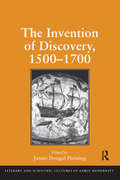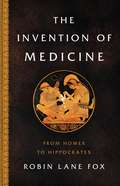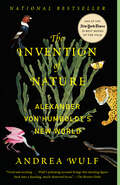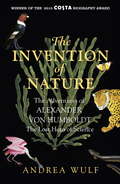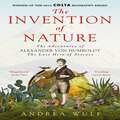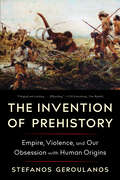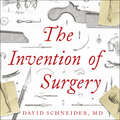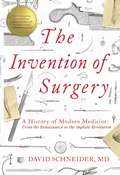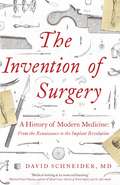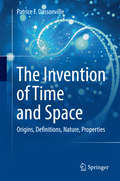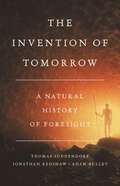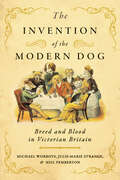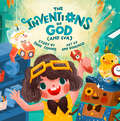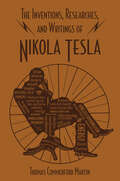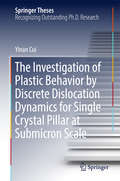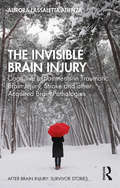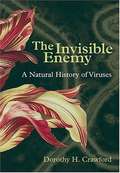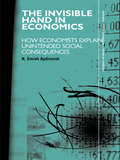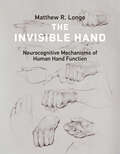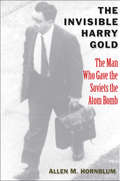- Table View
- List View
The Invention of Discovery, 1500–1700 (Literary And Scientific Cultures Of Early Modernity Ser.)
by James Dougal FlemingThe early modern period used to be known as the Age of Discovery. More recently, it has been troped as an age of invention. But was the invention/discovery binary itself invented, or discovered? This volume investigates the possibility that it was invented, through a range of early modern knowledge practices, centered on the emergence of modern natural science. From Bacon to Galileo, from stagecraft to math, from martyrology to romance, contributors to this interdisciplinary collection examine the period's generation of discovery as an absolute and ostensibly neutral standard of knowledge-production. They further investigate the hermeneutic implications for the epistemological authority that tends, in modernity, still to be based on that standard. The Invention of Discovery, 1500-1700 is a set of attempts to think back behind discovery, considered as a decisive trope for modern knowledge.
The Invention of Medicine: From Homer to Hippocrates
by Robin Lane FoxA preeminent classics scholar revises the history of medicine.Medical thinking and observation were radically changed by the ancient Greeks, one of their great legacies to the world. In the fifth century BCE, a Greek doctor put forward his clinical observations of individual men, women, and children in a collection of case histories known as the Epidemics. Among his working principles was the famous maxim "Do no harm." In The Invention of Medicine, acclaimed historian Robin Lane Fox puts these remarkable works in a wider context and upends our understanding of medical history by establishing that they were written much earlier than previously thought. Lane Fox endorses the ancient Greeks' view that their texts' author, not named, was none other than the father of medicine, the great Hippocrates himself. Lane Fox's argument changes our sense of the development of scientific and rational thinking in Western culture, and he explores the consequences for Greek artists, dramatists and the first writers of history. Hippocrates emerges as a key figure in the crucial change from an archaic to a classical world. Elegantly written and remarkably learned, The Invention of Medicine is a groundbreaking reassessment of many aspects of Greek culture and city life.
The Invention of Miracles: Language, Power, and Alexander Graham Bell's Quest to End Deafness
by Katie BoothFinalist for the PEN/Jacqueline Bograd Weld Award for Biography Finalist for the Mark Lynton History Prize &“Meticulously researched, crackling with insights, and rich in novelistic detail&” (Steve Silberman), this &“provocative, sensitive, beautifully written biography&” (Sylvia Nasar) tells the true—and troubling—story of Alexander Graham Bell&’s quest to end deafness. &“Researched and written through the Deaf perspective, this marvelously engaging history will have us rethinking the invention of the telephone.&” —Jaipreet Virdi, PhD, author of Hearing Happiness: Deafness Cures in History We think of Alexander Graham Bell as the inventor of the telephone, but that&’s not how he saw his own career. As the son of a deaf woman and, later, husband to another, his goal in life from adolescence was to teach deaf students to speak. Even his tinkering sprang from his teaching work; the telephone had its origins as a speech reading machine. The Invention of Miracles takes a &“stirring&” (The New York Times Book Review), &“provocative&” (The Boston Globe), &“scrupulously researched&” (Pittsburgh Post-Gazette) new look at an American icon, revealing the astonishing true genesis of the telephone and its connection to another, far more disturbing legacy of Bell&’s: his efforts to suppress American Sign Language. Weaving together a dazzling tale of innovation with a moving love story, the book offers a heartbreaking account of how a champion can become an adversary and an enthralling depiction of the deaf community&’s fight to reclaim a once-forbidden language. Katie Booth has been researching this story for more than fifteen years, poring over Bell&’s papers, Library of Congress archives, and the records of deaf schools around America. But she&’s also lived with this story for her entire life. Witnessing the damaging impact of Bell&’s legacy on her family would set her on a path that overturned everything she thought she knew about language, power, deafness, and the telephone.
The Invention of Nature: Alexander von Humboldt's New World
by Andrea WulfThe acclaimed author of Founding Gardeners reveals the forgotten life of Alexander von Humboldt, the visionary German naturalist whose ideas changed the way we see the natural world--and in the process created modern environmentalism.NATIONAL BEST SELLEROne of the New York Times 10 Best Books of the YearWinner of the Los Angeles Times Book Prize, The James Wright Award for Nature Writing, the Costa Biography Award, the Royal Geographic Society's Ness Award, the Sigurd F. Olson Nature Writing AwardFinalist for the Andrew Carnegie Medal for Excellence in Nonfiction, the Kirkus Prize Prize for Nonfiction, the Independent Bookshop Week Book AwardA Best Book of the Year: The New York Times, The Atlantic, The Economist, Nature, Jezebel, Kirkus Reviews, Publishers Weekly, New Scientist, The Independent, The Telegraph, The Sunday Times, The Evening Standard, The SpectatorAlexander von Humboldt (1769-1859) was an intrepid explorer and the most famous scientist of his age. In North America, his name still graces four counties, thirteen towns, a river, parks, bays, lakes, and mountains. His restless life was packed with adventure and discovery, whether he was climbing the highest volcanoes in the world or racing through anthrax-infected Siberia or translating his research into bestselling publications that changed science and thinking. Among Humboldt's most revolutionary ideas was a radical vision of nature, that it is a complex and interconnected global force that does not exist for the use of humankind alone. Now Andrea Wulf brings the man and his achievements back into focus: his daring expeditions and investigation of wild environments around the world and his discoveries of similarities between climate and vegetation zones on different continents. She also discusses his prediction of human-induced climate change, his remarkable ability to fashion poetic narrative out of scientific observation, and his relationships with iconic figures such as Simón Bolívar and Thomas Jefferson. Wulf examines how Humboldt's writings inspired other naturalists and poets such as Darwin, Wordsworth, and Goethe, and she makes the compelling case that it was Humboldt's influence that led John Muir to his ideas of natural preservation and that shaped Thoreau's Walden. With this brilliantly researched and compellingly written book, Andrea Wulf shows the myriad fundamental ways in which Humboldt created our understanding of the natural world, and she champions a renewed interest in this vital and lost player in environmental history and science.From the Hardcover edition.
The Invention of Nature: The Adventures of Alexander von Humboldt, the Lost Hero of Science: Costa & Royal Society Prize Winner
by Andrea WulfWINNER OF THE 2015 COSTA BIOGRAPHY AWARDWINNER OF THE ROYAL SOCIETY SCIENCE BOOK PRIZE 2016'A thrilling adventure story' Bill Bryson'Dazzling' Literary Review 'Brilliant' Sunday Express'Extraordinary and gripping' New Scientist'A superb biography' The Economist'An exhilarating armchair voyage' GILES MILTON, Mail on Sunday Alexander von Humboldt (1769-1859) is the great lost scientist - more things are named after him than anyone else. There are towns, rivers, mountain ranges, the ocean current that runs along the South American coast, there's a penguin, a giant squid - even the Mare Humboldtianum on the moon. His colourful adventures read like something out of a Boy's Own story: Humboldt explored deep into the rainforest, climbed the world's highest volcanoes and inspired princes and presidents, scientists and poets alike. Napoleon was jealous of him; Simon Bolívar's revolution was fuelled by his ideas; Darwin set sail on the Beagle because of Humboldt; and Jules Verne's Captain Nemo owned all his many books. He simply was, as one contemporary put it, 'the greatest man since the Deluge'.Taking us on a fantastic voyage in his footsteps - racing across anthrax-infected Russia or mapping tropical rivers alive with crocodiles - Andrea Wulf shows why his life and ideas remain so important today. Humboldt predicted human-induced climate change as early as 1800, and The Invention of Nature traces his ideas as they go on to revolutionize and shape science, conservation, nature writing, politics, art and the theory of evolution. He wanted to know and understand everything and his way of thinking was so far ahead of his time that it's only coming into its own now. Alexander von Humboldt really did invent the way we see nature.
The Invention of Nature: The Adventures of Alexander von Humboldt, the Lost Hero of Science: Costa & Royal Society Prize Winner
by Andrea WulfWINNER OF THE 2015 COSTA BIOGRAPHY AWARDWINNER OF THE ROYAL SOCIETY PRIZE 2016'Dazzling' Literary Review 'Brilliant' Sunday Express'Extraordinary and gripping' New Scientist'A superb biography' The Economist'An exhilarating armchair voyage' GILES MILTON, Mail on Sunday Alexander von Humboldt (1769-1859) is the great lost scientist - more things are named after him than anyone else. There are towns, rivers, mountain ranges, the ocean current that runs along the South American coast, there's a penguin, a giant squid - even the Mare Humboldtianum on the moon. His colourful adventures read like something out of a Boy's Own story: Humboldt explored deep into the rainforest, climbed the world's highest volcanoes and inspired princes and presidents, scientists and poets alike. Napoleon was jealous of him; Simon Bolívar's revolution was fuelled by his ideas; Darwin set sail on the Beagle because of Humboldt; and Jules Verne's Captain Nemo owned all his many books. He simply was, as one contemporary put it, 'the greatest man since the Deluge'.Taking us on a fantastic voyage in his footsteps - racing across anthrax-infected Russia or mapping tropical rivers alive with crocodiles - Andrea Wulf shows why his life and ideas remain so important today. Humboldt predicted human-induced climate change as early as 1800, and The Invention of Nature traces his ideas as they go on to revolutionize and shape science, conservation, nature writing, politics, art and the theory of evolution. He wanted to know and understand everything and his way of thinking was so far ahead of his time that it's only coming into its own now. Alexander von Humboldt really did invent the way we see nature.Recorded by arrangement with Doubleday, an imprint of the Knopf Doubleday Publishing Group, a division of Penguin Random House LLC; (P)2015 Highbridge, a division of Recorded Books
The Invention of Prehistory: Empire, Violence, And Our Obsession With Human Origins
by Stefanos Geroulanos“[A]n incisive and captivating reassessment of prehistory . . . In lucid prose, Geroulanos unspools an enthralling and detailed history of the development of modern natural science. It’s a must-read.” —Publishers Weekly, starred review “An astute, powerfully rendered history of humanity.” —Kirkus Reviews, starred review An eminent historian tells the story of how we came to obsess over the origins of humanity—and how, for three centuries, ideas of prehistory have been used to justify devastating violence against others. Books about the origins of humanity dominate bestseller lists, while national newspapers present breathless accounts of new archaeological findings and speculate about what those findings tell us about our earliest ancestors. We are obsessed with prehistory—and, in this respect, our current era is no different from any other in the last three hundred years. In this coruscating work, acclaimed historian Stefanos Geroulanos demonstrates how claims about the earliest humans not only shaped Western intellectual culture, but gave rise to our modern world. The very idea that there was a human past before recorded history only emerged with the Enlightenment, when European thinkers began to reject faith-based notions of humanity and history in favor of supposedly more empirical ideas about the world. From the “state of nature” and Romantic notions of virtuous German barbarians to theories about Neanderthals, killer apes, and a matriarchal paradise where women ruled, Geroulanos captures the sheer variety and strangeness of the ideas that animated many of the major thinkers of the eighteenth and nineteenth centuries, including Jean-Jacques Rousseau, Charles Darwin, and Karl Marx. Yet as Geroulanos shows, such ideas became, for the most part, the ideological foundations of repressive regimes and globe-spanning empires. Deeming other peoples “savages” allowed for guilt-free violence against them; notions of “killer apes” who were our evolutionary predecessors made war seem natural. The emergence of modern science only accelerated the West’s imperialism. The Nazi obsession with race was rooted in archaeological claims about prehistoric IndoGermans; the idea that colonialized peoples could be “bombed back to the Stone Age” was made possible by the technology of flight and the anthropological idea that civilization advanced in stages. As Geroulanos argues, accounts of prehistory tell us more about the moment when they are proposed than about the deep past—and if we hope to start improving our future, we would be better off setting aside the search for how it all started. A necessary, timely, indelible account of how the quest for understanding the origins of humanity became the handmaiden of war and empire, The Invention of Prehistory will forever change how we think about the deep past.
The Invention of Science: A New History of the Scientific Revolution
by David Wootton"Captures the excitement of the scientific revolution and makes a point of celebrating the advances it ushered in." —Financial TimesA companion to such acclaimed works as The Age of Wonder, A Clockwork Universe, and Darwin’s Ghosts—a groundbreaking examination of the greatest event in history, the Scientific Revolution, and how it came to change the way we understand ourselves and our world.We live in a world transformed by scientific discovery. Yet today, science and its practitioners have come under political attack. In this fascinating history spanning continents and centuries, historian David Wootton offers a lively defense of science, revealing why the Scientific Revolution was truly the greatest event in our history.The Invention of Science goes back five hundred years in time to chronicle this crucial transformation, exploring the factors that led to its birth and the people who made it happen. Wootton argues that the Scientific Revolution was actually five separate yet concurrent events that developed independently, but came to intersect and create a new worldview. Here are the brilliant iconoclasts—Galileo, Copernicus, Brahe, Newton, and many more curious minds from across Europe—whose studies of the natural world challenged centuries of religious orthodoxy and ingrained superstition.From gunpowder technology, the discovery of the new world, movable type printing, perspective painting, and the telescope to the practice of conducting experiments, the laws of nature, and the concept of the fact, Wotton shows how these discoveries codified into a social construct and a system of knowledge. Ultimately, he makes clear the link between scientific discovery and the rise of industrialization—and the birth of the modern world we know.
The Invention of Surgery
by Dr David SchneiderA fascinating history of the practice of surgery from one of the leading figures in the field, chronicling centuries of scientific breakthroughs by the discipline's most dynamic, pioneering doctors.Written by an author with plenty of experience holding a scalpel, Dr. David Schneider's The Invention of Surgery is an in-depth biography of the practice that has leapt forward over the centuries from the dangerous guesswork of ancient Greek physicians through the world-changing "implant revolution" of the twentieth century.The Invention of Surgery explains this dramatic progress and highlights the personalities of the discipline's most dynamic historical figures. It links together the lives of the pioneering scientists who first understood what causes disease, how organs become infected or cancerous, and how surgery could powerfully intercede in people's lives, and then shows how the rise of surgery intersected with many of the greatest medical breakthroughs of the last century, including the evolution of medical education, the transformation of the hospital from a place of dying to a habitation of healing, the development of antibiotics, and the rise of transistors and polymer science.And as Schneider argues, surgery has not finished transforming; new technologies are constantly reinventing both the practice of surgery and the nature of the objects we are permanently implanting in our bodies. Schneider considers these latest developments, asking "What's next?" and analyzing how our conception of surgery has changed alongside our evolving ideas of medicine, technology, and our bodies.(P) 2020 Dreamscape Media
The Invention of Surgery: A History Of Modern Medicine: From The Renaissance To The Implant Revolution
by David SchneiderA fascinating history of the practice of surgery from one of the leading figures in the field, chronicling centuries of scientific breakthroughs by the discipline's most dynamic, pioneering doctors. Written by an author with plenty of experience holding a scalpel, Dr. David Schneider’s The Invention of Surgery is an in-depth biography of the practice that has leapt forward over the centuries from the dangerous guesswork of ancient Greek physicians through the world-changing “implant revolution” of the twentieth century. The Invention of Surgery explains this dramatic progress and highlights the personalities of the discipline's most dynamic historical figures. It links together the lives of the pioneering scientists who first understood what causes disease, how organs become infected or cancerous, and how surgery could powerfully intercede in people’s lives, and then shows how the rise of surgery intersected with many of the greatest medical breakthroughs of the last century, including the evolution of medical education, the transformation of the hospital from a place of dying to a habitation of healing, the development of antibiotics, and the rise of transistors and polymer science. And as Schneider argues, surgery has not finished transforming; new technologies are constantly reinventing both the practice of surgery and the nature of the objects we are permanently implanting in our bodies. Schneider considers these latest developments, asking “What’s next?” and analyzing how our conception of surgery has changed alongside our evolving ideas of medicine, technology, and our bodies.
The Invention of Surgery: A History Of Modern Medicine: From The Renaissance To The Implant Revolution
by Dr David Schneider"Bold and compelling... Uniformly excellent, and often wryly amusing."" - The Wall Street Journal "A globetrotting historical adventure, told from the inside of the operating room... Medical writing at its most exhilarating." - Michael Paul Mason"Comprehensively researched, deftly told, and radiating both intellect and passion... Essential reading for anyone interested not only in the history but also in the future of medicine." - Frank Huyler"A history of surgery that is informative, entertaining, and highly readable." Library JournalA fascinating history of the practice of surgery from one of the leading figures in the field, chronicling centuries of scientific breakthroughs by the discipline's most dynamic, pioneering doctors.Written by an author with plenty of experience holding a scalpel, Dr. David Schneider's The Invention of Surgery is an in-depth biography of the practice that has leapt forward over the centuries from the dangerous guesswork of ancient Greek physicians through the world-changing "implant revolution" of the twentieth century.The Invention of Surgery explains this dramatic progress and highlights the personalities of the discipline's most dynamic historical figures. It links together the lives of the pioneering scientists who first understood what causes disease, how organs become infected or cancerous, and how surgery could powerfully intercede in people's lives, and then shows how the rise of surgery intersected with many of the greatest medical breakthroughs of the last century, including the evolution of medical education, the transformation of the hospital from a place of dying to a habitation of healing, the development of antibiotics, and the rise of transistors and polymer science.And as Schneider argues, surgery has not finished transforming; new technologies are constantly reinventing both the practice of surgery and the nature of the objects we are permanently implanting in our bodies. Schneider considers these latest developments, asking "What's next?" and analyzing how our conception of surgery has changed alongside our evolving ideas of medicine, technology, and our bodies.
The Invention of Time and Space
by Patrice F. DassonvilleThis investigation of time and space is motivated by gaps in our current understanding: by the lack of definitions, by our failure to appreciate the nature of these entities, by our inability to pin down their properties. The author's approach is based on two key ideas: The first idea is to seek the geo-historical origins of time and space concepts. A thorough investigation of a diversified archaeological corpus, allows him to draft coherent definitions; it furthermore gives clues as to whether time and space were discovered or invented. The second idea is to define the units before trying to define space and time. The results presented here are unexpected: Time and space were not discovered in nature, but they were invented; time is not a phenomenon and space has no materiality; they are only concepts. This runs contrary to the opinion of most scientific and the philosophical authorities, although one would seek in vain for a theoretical validation of the conventional position. This book will provide much food for thought for philosophers and scientists, as well as interested general readers.
The Invention of Tomorrow: A Natural History of Foresight
by Thomas Suddendorf Jonathan Redshaw Adam BulleyA spellbinding exploration of the human capacity to imagine the future Our ability to think about the future is one of the most powerful tools at our disposal. In The Invention of Tomorrow, cognitive scientists Thomas Suddendorf, Jonathan Redshaw, and Adam Bulley argue that its emergence transformed humans from unremarkable primates to creatures that hold the destiny of the planet in their hands. Drawing on their own cutting-edge research, the authors break down the science of foresight, showing us where it comes from, how it works, and how it made our world. Journeying through biology, psychology, history, and culture, they show that thinking ahead is at the heart of human nature—even if we often get it terribly wrong. Incisive and expansive, The Invention of Tomorrow offers a fresh perspective on the human tale that shows how our species clawed its way to control the future.
The Invention of the Modern Dog: Breed and Blood in Victorian Britain (Animals, History, Culture)
by Julie-Marie Strange Michael Worboys Neil PembertonThe story of the thoroughly Victorian origins of dog breeds.For centuries, different types of dogs were bred around the world for work, sport, or companionship. But it was not until Victorian times that breeders started to produce discrete, differentiated, standardized breeds. In The Invention of the Modern Dog, Michael Worboys, Julie-Marie Strange, and Neil Pemberton explore when, where, why, and how Victorians invented the modern way of ordering and breeding dogs. Though talk of "breed" was common before this period in the context of livestock, the modern idea of a dog breed defined in terms of shape, size, coat, and color arose during the Victorian period in response to a burgeoning competitive dog show culture. The authors explain how breeders, exhibitors, and showmen borrowed ideas of inheritance and pure blood, as well as breeding practices of livestock, horse, poultry and other fancy breeders, and applied them to a species that was long thought about solely in terms of work and companionship.The new dog breeds embodied and reflected key aspects of Victorian culture, and they quickly spread across the world, as some of Britain’s top dogs were taken on stud tours or exported in a growing international trade. Connecting the emergence and development of certain dog breeds to both scientific understandings of race and blood as well as Britain’s posture in a global empire, The Invention of the Modern Dog demonstrates that studying dog breeding cultures allows historians to better understand the complex social relationships of late-nineteenth-century Britain.
The Inventions of God (Made in His Image)
by Dave ConnisThis delightfully illustrated picture book tells the story of inventor extraordinaire Eva—and the God who created her to be a lot like Him.Little Eva is a budding engineer who loves to invent machines, toys, and robots that bring her joy. But where does her curiosity, creativity, and pizzazz come from? Meet God. He loves to invent, too, and delights in His creations, especially Eva. God and Eva are A LOT alike because God made Eva to be just like Him.Eva loves her inventions, but maybe not their earlier versions. God loves Eva, every version of her, and He wants her to know just how much. Parents and children alike will relish the playful illustrations and the gentle reminder that the image of God is alive in each of us.
The Inventions, Researches, and Writings of Nikola Tesla: With Special Reference To His Work In Polyphase Currents And High Potential Lighting (classic Reprint) (Wordsworth Classics)
by Thomas Commerford MartinThe early works of famed inventor Nikola Tesla, and a source of inspiration for generations of innovators. At the time it was first published in 1893, The Inventions, Researches, and Writings of Nikola Tesla was considered the bible of electrical engineering and inspired generations of inventors. This volume, edited by Tesla’s contemporary, Thomas Commerford Martin, includes extensive discussion of Tesla’s early work and inventions and contains more than 300 illustrations that demonstrate the practical application of his ideas. Tesla, who was born in what is now Croatia, is best known for his research into the use of high-frequency alternating currents and wireless transmission. Many of his ideas have found practical application in the modern world, and he continues to be a source of inspiration and fascination to this day.
The Inventor Says: Quotes, Quips and Words of Wisdom
by Kevin LippertThe sixth in our popular Words of Wisdom series, The Inventor Says invites readers to a gathering of history's most brilliant creative minds, where inventors past and present jostle, compete, contradict, and compliment each other. Groundbreakers such as Leonardo da Vinci, Benjamin Franklin, Henry Ford, Ada Lovelace, the Wright Brothers, and Sejong the Great converse with the twentieth century's most ingenious tinkerers and thinkers, from Buckminster Fuller, Ruth Handler (creator of the Barbie doll), Nikola Tesla (who cuts Thomas Edison down to size for his lack of scientific discipline), and Apple's Steve Wozniak to contemporary figures like Lisa Seacat DeLuca, IBM's most prolific female inventor. These intrepid innovators discuss their childhood, inspirations, working habits, failure as a productive stage in the creative process, and much more, in a collection that will inspire readers to hatch a few brilliant ideas of their own. As Edwin Land advised: "Don't undertake a project unless it is manifestly important and nearly impossible."
The Inventor's Secret: What Thomas Edison Told Henry Ford
by Suzanne SladeBoth Thomas Edison and Henry Ford started off as insatiably curious tinkerers. That curiosity led them to become inventors—with very different results. As Edison invented hit after commercial hit, gaining fame and fortune, Henry struggled to make a single invention (an affordable car) work. Witnessing Thomas's glorious career from afar, a frustrated Henry wondered about the secret to his success. This little-known story is a fresh, kid-friendly way to show how Thomas Edison and Henry Ford grew up to be the most famous inventors in the world—and best friends, too.
The Invertebrate Tree of Life
by Gonzalo Giribet Gregory D. EdgecombeThe most up-to-date book on invertebrates, providing a new framework for understanding their place in the tree of lifeIn The Invertebrate Tree of Life, Gonzalo Giribet and Gregory Edgecombe, leading authorities on invertebrate biology and paleontology, utilize phylogenetics to trace the evolution of animals from their origins in the Proterozoic to today. Phylogenetic relationships between and within the major animal groups are based on the latest molecular analyses, which are increasingly genomic in scale and draw on the soundest methods of tree reconstruction.Giribet and Edgecombe evaluate the evolution of animal organ systems, exploring how current debates about phylogenetic relationships affect the ways in which aspects of invertebrate nervous systems, reproductive biology, and other key features are inferred to have developed. The authors review the systematics, natural history, anatomy, development, and fossil records of all major animal groups, employing seminal historical works and cutting-edge research in evolutionary developmental biology, genomics, and advanced imaging techniques. Overall, they provide a synthetic treatment of all animal phyla and discuss their relationships via an integrative approach to invertebrate systematics, anatomy, paleontology, and genomics.With numerous detailed illustrations and phylogenetic trees, The Invertebrate Tree of Life is a must-have reference for biologists and anyone interested in invertebrates, and will be an ideal text for courses in invertebrate biology.A must-have and up-to-date book on invertebrate biologyIdeal as both a textbook and referenceSuitable for courses in invertebrate biologyRichly illustrated with black-and-white and color images and abundant tree diagramsWritten by authorities on invertebrate evolution and phylogenyFactors in the latest understanding of animal genomics and original fossil material
The Investigation of Plastic Behavior by Discrete Dislocation Dynamics for Single Crystal Pillar at Submicron Scale
by Yinan CuiThis thesis transports you to a wonderful and fascinating small-scale world and tells you the origin of several new phenomena. The investigative tool is the improved discrete dislocation-based multi-scale approaches, bridging the continuum modeling and atomistic simulation. Mechanism-based theoretical models are put forward to conveniently predict the mechanical responses and defect evolution. The findings presented in this thesis yield valuable new guidelines for microdevice design, reliability analysis and defect tuning.
The Invisible Brain Injury: Cognitive Impairments in Traumatic Brain Injury, Stroke and other Acquired Brain Pathologies (After Brain Injury: Survivor Stories)
by Aurora Lassaletta AtienzaThe Invisible Brain Injury recounts, in her own words, the experience of Aurora Lassaletta, a clinical psychologist who suffered a traumatic brain injury (TBI) after a traffic accident. Presenting her unique dual perspective as both a patient and a clinician, Aurora highlights the less visible cognitive, emotional and behavioural symptoms common to acquired brain injury (ABI). This moving account showcases Aurora’s growing awareness of her impairments, their manifestation in daily life, how they are perceived, or not, by others and the tools that helped her survive. Each chapter combines Aurora’s perspective with the scientific view of a professional neuropsychologist or physiatrist who provide commentaries on her various symptoms. This book is valuable reading for professionals involved in neurorehabilitation and clinical neuropsychology and for clinical psychology students. It is a must read for ABI survivors, those around them and clinicians, who are all an essential part of the rehabilitation, adjustment and acceptance process involved with ABI.
The Invisible Enemy: A Natural History of Viruses
by Dorothy CrawfordIn 1969 the US Surgeon General confidently declared, "We can now close the book on infectious diseases." The advent of AIDS has proven him spectacularly wrong, and in recent years the world has witnessed infectious outbreaks of other highly lethal viruses such as Hanta, Ebola, and Lassa fever. Flu strains are getting stronger and stronger each year. But what, exactly, is a virus? How does it work? And what is the best way to fight it? In Invisible Enemy, Dorothy Crawford offers clear answers to these and many other questions. She shows precisely how viruses, with their amazing ability to mutate, have caused devastating diseases in the past, and continue to pose one of the greatest challenges to science. A virus is disarmingly small and simple--a minute piece of genetic material wrapped in a protein coat. And yet it can cause major chaos. Smallpox killed over 300 million people in the twentieth century before it was eradicated in 1980; at that time, measles still killed two and half million children a year; and the HIV virus is now the leading cause of death in Africa. Crawford lucidly explains all aspects of these deadly parasites and discusses controversial subjects such as CFS and Gulf War Syndrome. She goes on to consider how we've coped with viruses in the past, where new viruses come from, and whether a new virus could wipe out the human race. For anyone seeking a deeper understanding of these remarkably efficient killers, Invisible Enemy provides a compelling account of their history, their effects on us, and their possible future.
The Invisible Hand in Economics: How Economists Explain Unintended Social Consequences (Routledge Inem Advances In Economic Methodology Ser.)
by N. Emrah AydinonatThis is a book about one of the most controversial concepts in economics: the invisible hand. The author explores the unintended social consequences implied by the invisible hand and discusses the mechanisms that bring about these consequences.The book questions, examines and explicates the strengths and weaknesses of invisible-hand explanations co
The Invisible Hand: Neurocognitive Mechanisms of Human Hand Function
by Matthew R. LongoHow the &“invisible hand&” of the nervous system makes the human hand such an evolutionary success.The hand has a central role in both human evolution and cultural development—in our descent and in our ascent. It is, Immanuel Kant said, &“the visible part of the brain.&” It is the invisible that concerns Matthew Longo in The Invisible Hand, a wide-ranging, deftly written account of the neural and cognitive mechanisms that have made a seemingly ordinary physical appendage an extraordinary tool in the evolution of humanity.The hand has been the focus of an enormous amount of research from a dizzying range of disciplines, from anatomy, psychology, and neuroscience to evolutionary biology and archaeology. With the concept of the invisible hand, Longo integrates and contextualizes the findings from these disparate fields to show how the neurocognitive mechanisms that comprise the invisible hand are central to understanding a wide array of phenomena, including basic sensory and motor function, space perception, gesture, and even the self. More generally, he contends that the extraordinary abilities of the hand arise precisely from the complementary nature and tight integration of the visible and invisible hands—a proposition that leads deep into topics as diverse as haptics, tool use, handedness, phantom limbs, and evolution. His work elucidates and significantly expands a key chapter of the story of human evolution and culture as manifested in the human hand.
The Invisible Harry Gold
by Allen M. HornblumIn the history of Soviet espionage in America, few people figure more crucially than Harry Gold. A Russian Jewish immigrant who spied for the Soviets from 1935 until 1950, Gold was an accomplished industrial and military espionage agent. He was assigned to be physicist Klaus Fuchs's "handler" and ultimately conveyed sheaves of stolen information about the Manhattan Project from Los Alamos to Russian agents. He is literally the man who gave the USSR the plans for the atom bomb. The subject of the most intensive public manhunt in the history of the FBI, Gold was arrested in May 1950. His confession revealed scores of contacts, and his testimony in the trial of the Rosenbergs proved pivotal. Yet among his co-workers, fellow prisoners at Lewisburg Penitentiary, and even those in the FBI, Gold earned respect, admiration, and affection. InThe Invisible Harry Gold, journalist and historian Allen Hornblum paints a surprising portrait of this notorious yet unknown figure. Through interviews with many individuals who knew Gold and years of research into primary documents, Hornblum has produced a gripping account of how a fundamentally decent and well-intentioned man helped commit the greatest scientific theft of the twentieth century.
